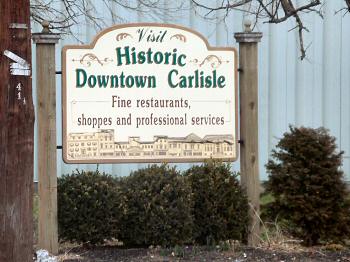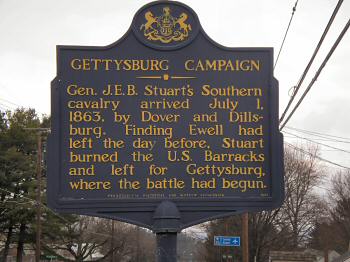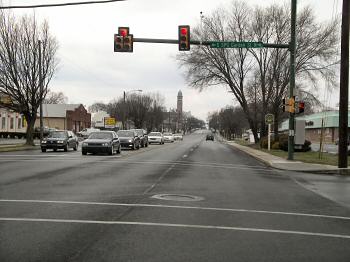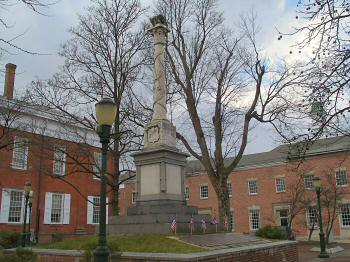|
Confederate Occupation of Carlisle,
Pennsylvania
By the summer of 1863, the American Civil War had raged for two years,
with some of the heaviest fighting occurring in the Confederate state of
Virginia. In an attempt to take the fighting to the northern states,
Confederate Commanding General Robert E Lee proposed an invasion of
Pennsylvania. By June 1863, the citizens of Carlisle, Pennsylvania had
heard rumors that a great Confederate army was marching from the south
with the aim of capturing the state capital of Harrisburg. The citizens
became a bit more concerned when the soldiers at the Federal Army's
cavalry school at the Carlisle Barracks were withdrawn to Harrisburg. The
Union command had decided that Carlisle was to be given to the enemy
without a struggle to prevent loss of civilian life and damage to
property. In fact, the plan was to allow the rebels to capture all of
Cumberland County and stop them at the bridges across the Susquehanna
River, preventing them their prize of the capital city. This overall
strategy was small comfort for the folks in Carlisle however, facing an
advancing enemy army. Confederate General Richard Ewell's forces reached
the outskirts of town on 27 June. He was met soon after by a deputation of
leading citizens under a flag to truce to arrange the surrender of the
town.
Ewell's forces entered the town and set up campsites all over town to
guard its approaches and maintain order. One brigade pitched their tents
on the campus of Dickinson College to command the western approaches into
town. Another occupied a position at the junction of Trindle Road and
Dillsburg Road (in the general location of today's video rental store).
Another occupied the deserted Carlisle Barracks. A couple of companies
camped in the centre of town to maintain order. In all, some 12,000
Confederate troops occupied the town and its environs. Almost at once,
they began placing demands on the townspeople, asking for 25,000 pounds of
bacon, 100 sacks of salt, 1500 barrels of potatoes and molasses, 5000
pounds of coffee and 25 barrels of dried fruit. It is unclear if the
townspeople met his demands, but Ewell's men did find several barrels of
whisky and had a grand time while they were in town.
On the afternoon of 28 June, the 32nd North Carolina Regiment raised a
Confederate flag over the Carlisle Barracks, making it the northern-most
military installation captured by the rebels. The fun ended the very next
day when General Robert E Lee ordered Ewell and his men to march toward
Gettysburg, as Lee attempted to consolidate his far-flung army.
The townspeople in Carlisle cheered the departure of the Confederates and
the return of General WF Smith's Union troops to the Carlisle Barracks the
next day. But their jubilation was short-lived as they learned on 1 July
that Confederate cavalry forces under the command of General JEB Stuart
were approaching the town to re-supply his troops. This time the Union
soldiers didn't retreat. As General FitzHugh Lee's rebel forces approached
the town, they came under fire from Union troops. The Confederates fired
several cannonballs down High Street into the town square. Lee then sent a
deputation into the town seeking its surrender or the withdrawal of its
women and children. Smith responded that the women and children would
leave. The bombardment of the town by the Confederates then resumed.
Estimates place the number of shots fired into the town at 135. Several
homes were damaged, a few soldiers were wounded and one horse was killed.
The columns outside the Old Courthouse on the town square still bear the
scars from this Rebel shelling. Lee sent two more demands for the town's
surrender before he set fire to a lumberyard and most of the Carlisle
Barracks. He then withdrew his forces at midnight.
Historical Significance
Some might argue that the Confederate occupation of Carlisle was little
more than sideshow leading up to the main action at Gettysburg a few days
later. However, it is important to remember that Stuart's mission during
the Confederate invasion of Pennsylvania was to serve as the eyes and ears
of Lee's main army. The fact that Stuart's cavalry troops wasted an entire
day at Carlisle left Lee's army blind in the process, at a time when he
needed intelligence about the size of the Federal force opposing him on
those hills outside Gettysburg. Many historians contend that Lee would
have never engaged in a decisive battle with the Union Army had he known
the size of the force facing him. |



